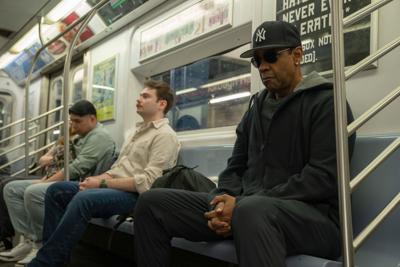As the legendary (and fictional) record producer David King — a.k.a. King — in Spike Lee’s new thriller, “Highest 2 Lowest,” Denzel Washington evokes authentic music moguls like Russell Simmons and Quincy Jones. He’s also, clearly, playing a hybrid version of himself and his director — a phenomenally successful Black entertainer who finds himself with no worlds left to conquer.
Because Lee’s film is a remake of Akira Kurosawa’s 1963 classic, “High and Low” — about a wealthy executive weighing whether or not to pay an exorbitant ransom to a man who claims to have kidnapped his teenage son — we know from the beginning that King is about to crash down to earth. The excitement lies in the way Lee crosses the streams between the plot and themes of Kurosawa’s film (itself an adaptation of an American novel) and his own preoccupation with the shifting expectations and values around contemporary pop and politics.
Even before receiving the phone call that plunges him into a paranoid nightmare, King feels as if there’s a target on his back. The line between being a symbol of Black excellence and a scapegoat for a generation trying to cram its foot in the door is razor-thin, and moving with the nervous energy of a man younger — and hungrier — than his years, Washington tap dances all over it.
On one level, “Highest 2 Lowest” is very much a film of ideas, juxtaposing King’s outsized wealth (and appetites) with the self-effacing modesty of his driver, Paul (Jeffrey Wright), an ex-con and devout Muslim who lives graciously in his employer’s debt. The dichotomy between the two men deepens when — in a plot point carried over from Kurosawa — it turns out that the kidnappers accidentally snatched Paul’s son, a case of mistaken identity that complicates the plan to pay them off.
Here, Lee and screenwriter Alan Fox duly scrutinize issues of class, privilege and noblesse oblige — as well as the way the NYPD officers assigned to the case seem less enthusiastic once it’s revealed that the missing party is the son of a felon. The situation and sociological commentary are pressurized further by the ambient, overwhelming presence of a social mediasphere chomping at the bit to paint King as a miser. He is, understandably, reluctant to pay $17 million and change for somebody else’s son.
At the same time, with his finances in disarray and his record company on the chopping block, can he afford to do the right thing? Can he afford not to?
Such is the stuff of great melodrama, and Lee makes King’s moral dilemma into compelling cinema through sheer force of technique. The camera roams and leaps through King’s lavishly appointed penthouse with style and purpose. When the movie switches gears and moves to street level — or actually underground, with an extended set piece on a crosstown train — Lee gets even wilder, mounting a chase sequence that ranks with anything in “The French Connection.”
The director’s desire to show off New York in all of its sweltering, swarming diversity has rarely been so palpable, and the city plays itself with aplomb. It’d right to call the skyline the star of the movie if not for the fact that Washington — working with Lee for the first time since 2006’s similarly propulsive “Inside Man” — delivers a charismatic, booby-trapped tour de force. Gaunt and elongated beneath an omnipresent Yankee cap that, like the myriad other sports logos in “Highest 2 Lowest,” pulls double duty as a symbol of civic pride, he’s a figure of comic-book cool riven with contradictions: a family man and an iconoclast, a mercenary philanthropist, a proudly old-school producer who keeps his iTunes playlist pointed toward the future.
“Highest 2 Lowest” takes liberties with its source material, and it doesn’t matter that they don’t all work. Like his protagonist, Lee is more interested in the potential of remixing over high fidelity. This is a weird, wild and occasionally hilarious movie, beautifully photographed in sweeping widescreen by Matthew Libatique and littered with needle-drops that only Lee can get away with — like, say, using a song from “Oklahoma!” to soundtrack images of the Big Apple.
In this context of stylistic flexing, the occasional lapses in logic scarcely matter. The question of what happens in the story is subordinate to how it’s being told, which is as it should be — and in its way, a true homage to Kurosawa, who shouldn’t be imitated, even by another master.
In the end, “Highest 2 Lowest” feels — very enjoyably — like an allegory of itself, with Lee using King’s redemption arc to prove that he’s still got the juice himself. Lee is 68 years old, and Washington is 70: kudos to them for making something that leaves nearly every other American movie released this year sucking wind.






























To join the conversation set a first and last name in your user profile.
Sign in or register for free to join the Conversation